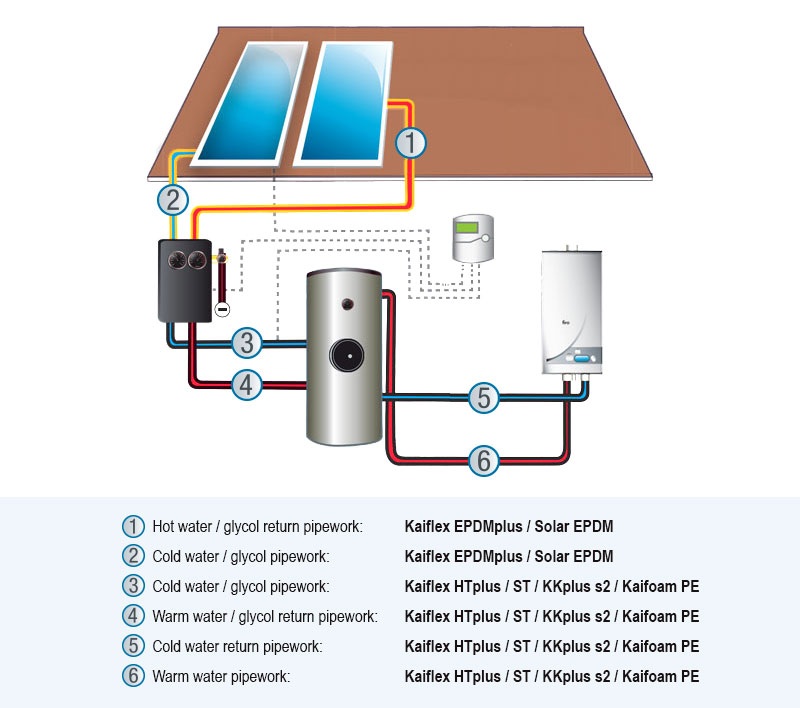
Solar collectors store solar energy in a fluid medium, convert this into heat and pipe it to a solar storage tank (drinking or buffer water) that transfers the heat to the household water supply. In 2018 alone, 71,000 new solar thermal systems were installed in Germany, and at the end of the year about 2.36 million were registered. What’s more, this number is growing.
Depending on the size of the collector, a system can heat water for showering or bathing, or help heat the house. In the summer months, a solar thermal system generates more heat than is needed. Energy losses are not a factor during this period. However, the situation is quite different in the winter. When days are short and the sky is overcast, energy yield is low and the boiler needs to come on to help heat the water. In order for the entire solar thermal system to work efficiently, good pipe insulation is crucial. After all, the less heat is lost on the way from the rooftop collector to the buffer storage tank in the cellar, the more heating fuel is saved and with it CO2.
Insulate properly – but how?
Most solar thermal systems are indirect. That means that instead of heating water directly, the solar module heats a glycol-water mixture that does not come into contact with drinking water. The glycol-water mixture circulates in a closed system through the solar modules, to the storage tank, and back. Inside the storage tank, the glycol-water mixture stays inside a ring tube, which works effectively as a heating element. If the pipes between the module and tank are poorly or not at all insulated, valuable heat is lost and the efficiency of the entire system is impaired.
In an indirect solar thermal system, the pipes from the module act as a heat source for the hot water tank. To minimise energy losses in winter, all pipes between the collector and hot water tank need to be carefully and correctly insulated.
Solar modules are incredibly efficient at absorbing solar energy, and under the right conditions, the temperature of the glycol-water mixture flowing through the module can reach 150 °C. Therefore, standards for outside are higher than for inside the building. Outside pipes should be insulated only with solar-quality material. Kaiflex Solar EPDM/Kaiflex EPDMplus is a good choice. This elastomer insulator is heat-resistant to +150 °C. This is very important for solar system pipes, because as the temperature of the fluid pipes rises above 100 °C, many other types of insulation melt or harden, thus losing their functionality. Kaiflex Solar EPDM/Kaiflex EPDMplus can stand up to these kinds of temperatures, and retains its flexibility in the entire range between +150 °C and –50 °C.
The rest of the plumbing on the other side of the hot water tank works like a normal hot water system, at normal temperatures. These pipes can be safely insulated with regular household plumbing insulation like Kaifoam PE, Kaiflex HT s2, Kaiflex KKplus s2 or Kaiflex ST.

Damage to insulation leads to energy losses
Outdoor insulation can be damaged not only by heat, but also by UV radiation, ozone and animals using it as material for their nests. Regardless of the cause, whether thermal or mechanical, damage to the insulating layer results in thermal bridges which lead to costly energy losses.
Kaiflex Solar EPDM or Kaiflex EPDMplus is ideal here as well. It has excellent UV resistance and ensures reliable insulating performance over the lifetime of the system. Tough coatings like Kaiflex Protect keep the insulating material free of damage, for effectiveness lasting many years. For easy installation, we offer Kaiflex Solar EPDMplus 2in2. This product consists of two pre-insulated corrugated stainless steel pipes (VA). Kaiflex Solar EPDMplus 2in2 efficiently connects solar collectors and heat storage tanks, minimising energy losses and keeping solar-heated water hot for longer. The insulation consists of UV-resistant EPDM synthetic rubber, and is co-extruded with a film that provides lasting protection against mechanical damage from outdoor weather. The supply and return pipes are marked and easy to differentiate.





















